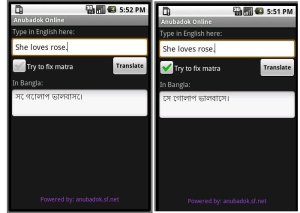On the new year’s day, the Anandabazar Patrika, the largest Bengali newspaper from West Bengal, begins one of their editorial with the sentence — “সাম্প্রতিক পশ্চিমবঙ্গের জনপ্রিয়তম শব্দবন্ধ ‘পরিবর্তন চাই’” (“The most popular words in recent Bengal — ‘We want change'” ). The same editorial ends with the proposition — “নূতন বৎসরের মূলমন্ত্র হউক ‘পরিবর্তন চাই’” (“Let the mantra for new-year be — ‘we want change’ “). Leaving aside the politics, there is a serious need of change in technology adoption in West Bengal and that is to help its beloved language Bengali to survive in its digital avatar.
In their own words, the Anandabazar Patrika (ABP) may sound like a champion of change but in practice they are no different. Being a leader in Bengali publishing industry, one might expect them to be in forefront in improving the digital standard for Bengali. Unfortunately, their action speaks just the opposite. They continue to use non-standard, bitstream font technology in their website instead of using international standard, the Unicode. One of their “supported browser” is Netscape Communicator whose official support has ended in 2008. They also recommend the use of Firefox plugin Padma. Being the author of ABP support in Padma, this seems rather strange to me. They are asking users to convert their contents to Unicode (by using Padma) rather than serving their contents directly using Unicode.
It may be mentioned that like many other non-Latin languages, digital representation of Bengali texts suffered from a lack of encoding standard in its early phase. However with the advent of Unicode, the universal encoding standard, this is no longer an issue. The Unicode standard has been widely adopted across different operating systems and all recent versions of Windows, Mac or Linux support Unicode natively. According to a statistics from the internet giant Google, the Unicode is most frequently used encoding on the internet since 2008.
Nevertheless, there has been a significant increase in Unicode adoption also for Bengali in recent past. Let me mention some of them.
Bangladesh:
In may be noted that Bengali is the national language of Bangladesh and they too suffered from the same problem. However, there has been a dramatic increase in adoption of Unicode lately. The largest news paper from Bangladesh by circulation, the Prothom Alo, has now switched to Unicode. Until recently they were using their own proprietary encoding. Other prominent news papers that have switched to Unicode from proprietary encoding are Amar Desh, Sangbad, Daily Sangram, Manab Zamin, Samakal.
West Bengal:
The West Bengal government has now adopted Unicode 5.0 as the standard encoding for Bengali. Their official website Banglar Mukh has finally switched to Unicode. Furthermore, with their funding the entire literary work of Nobel laureate Rabindranath Tagore has been released using Unicode. Tagore’s works are now in public domain due to the expiration of copyrights. The credits for these encouraging developments must go to the Society for Natural Language Technology Research and the company behind some of these implementations, the MAT-3 Impex.
Coming back to the technology front, there is now a new kid in the great browser arena, the Google Chrome. This snappy browser while supports Unicode natively, currently uses a buggy font for Bengali by default. This causes some Bengali texts to appear garbled. Most of these issues can be solved by simply changing its default font. To do so click on
Wrench-->Options-->Under the Hood-->Change fonts and language settings
and then choose the font of your choice for Bengali. For example in Ubuntu you can choose Freesans or Freeserif. These fonts have nice glyphs for Bengali.
Read Full Post »

